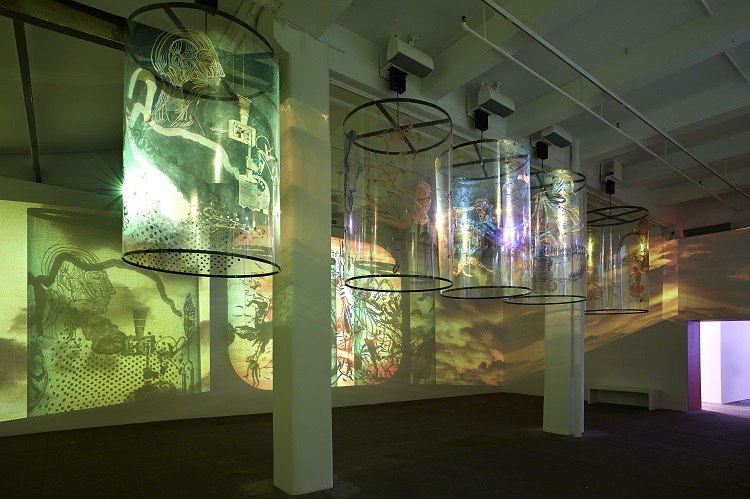
Installation view, Nalini Malani: In Search of Vanished Blood, Galerie Lelong, New York, September 6 – October 26, 2013. Courtesy the artist and Galerie Lelong, New York. © Nalini Malani.
(Boston, MA — Jan. 13, 2016) On July 1, the Institute of Contemporary Art/Boston (ICA) opens an immersive video installation by Mumbai-based artist Nalini Malani (b. 1946, Karachi). Organized by Eva Respini, Barbara Lee Chief Curator, In Search of Vanished Blood will open to the public on June 29 and remain on view until October 16, 2016. Malani, India’s foremost media and installation artist, has dedicated her career to artistic achievement as well as activism for women’s rights in her home country and across the globe. This exhibition showcases her groundbreaking installation, In Search of Vanished Blood, which was commissioned by Documenta 13, and premiered in Kassel, Germany in 2012. This immersive multi-media work features six 11-minute projections cast through painted rotating Mylar cylinders suspended from the ceiling. Visitors will witness an intricate shadowplay as an array of layered images are cast onto the gallery walls, enveloping viewers in a dazzling multi-media environment.
Born in Karachi, but forced to move to India following the 1947 partition of India, Malani channeled her life experiences directly into her art. Initially trained as a painter, Malani expanded her interests into video and installation projects that invoked references to her cultural and historical past while also grappling with the inequities of women’s rights. In Search of Vanished Blood takes its name from a poem written by Pakistani poet Faiz Ahmed Faiz which captures the intricacies of love, war, loss, and bloodshed within a country rocked by political unrest. Malani’s installation revives this history by painted elements that adorn the suspended Mylar cylinders as reference to Eastern and Western historical and cultural iconography, including sources such as Homer’s Illiad to the Ramayana. When illuminated, these icons dance around the room, complemented by an audio track. Malani brings these rich and complex historical narrative threads together with In Search of Vanished Blood.
The presentation of Malani’s installation will be accompanied by additional works on paper and a stop-motion animation.
About the artist
Born in Karachi, India (now Pakistan) in 1946, Nalini Malani received her artistic training at the Sir Jamsetjee Jeejebhoy School of Art in Mumbai (1964-1969). Malani’s work is influenced by her experiences as a refugee of the Partition of India. She places inherited iconographies and cherished cultural stereotypes under pressure. Her point of view is unwaveringly urban and internationalist, and unsparing in its condemnation of a cynical nationalism that exploits the beliefs of the masses. Hers is an art of excess, going beyond the boundaries of legitimized narrative, exceeding the conventional and initiating dialogue. Characteristics of her work have been the gradual movement towards new media, international collaboration and expanding dimensions of the pictorial surface into the surrounding space as ephemeral wall drawing, installation, shadow play, multi projection works and theatre. Malani was awarded the prestigious Fukuoka Prize 2013 for Arts and Culture.
The Institute of Contemporary Art/Boston (ICA) announces its exhibition schedule into 2017. Upcoming exhibitions include a major solo show of Walid Raad opening this February and an exhibition celebrating the museum’s first decade of collecting opening in August. For more information, please contact Kate Shamon, kshamon@icaboston.org, 617-478-3143.

Walid Raad
Feb. 24 – May 30, 2016
The ICA opens a comprehensive survey of the artist Walid Raad, a pivotal figure in contemporary art whose work investigates the ways in which we represent, remember, and make sense of history. The exhibition brings together nearly 150 works across various mediums—including photography, video, sculpture, and performance. Informed by his upbringing in Lebanon during the civil war (1975–90) and by the socioeconomic and military policies that have shaped the Middle East in the past few decades, Raad’s work is dedicated to exploring archives and photographic documents in the public realm, the role of memory and narrative within discourses of conflict, and the construction of histories of art in the Arab world. The exhibition is accompanied by a scholarly publication. This exhibition is organized by The Museum of Modern Art, New York. The exhibition is curated by Eva Respini, Barbara Lee Chief Curator, the Institute of Contemporary Art/Boston, with Katerina Stathopoulou, Curatorial Assistant, Department of Photography, The Museum of Modern Art, New York. The Boston presentation is coordinated by Jeffrey De Blois, Curatorial Assistant, the Institute of Contemporary Art/Boston. Following its presentation in Boston, the exhibition will travel to the Museo Jumex, Mexico City (Oct. 13, 2016–Jan.14, 2017).
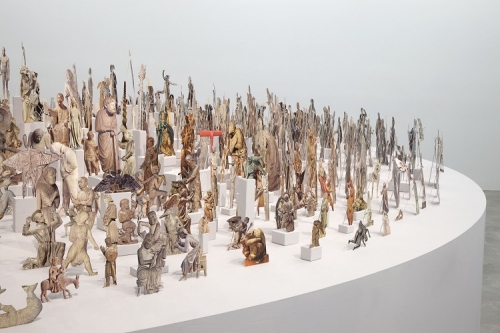
Geoffrey Farmer
April 13 — July 17, 2016
Geoffrey Farmer is best known for his installations and sculptural photo collages. Three large-scale works—two “paper works” and a new major film work—create the foundation for this exhibition. Each spectacular composition begins to chart the historical contours of our image-saturated contemporary culture, and suggest recurring cultural themes and formal patterns. Farmer uses movement, sound, animation, puppet characters, and a panoply of highly choreographed bodies and characters to investigate world history from the different angles of its photographic and sculptural accounts. Organized by Dan Byers, Mannion Family Senior Curator, with Jessica Hong, Curatorial Assistant.
Nalini Malani: In Search of Vanished Blood
July 1 – Oct. 16, 2016
Nalini Malani is India’s foremost video and installation artist and committed activist for women’s rights. This exhibition centers on her signature multi-media work, In Search of Vanished Blood (2012), accompanied by a selection of related works on paper. The work is comprised of six video projections streamed around the room through five hand-painted Mylar cylinders. As the cylinders rotate, colorful and layered iconography from Eastern and Western cultures is projected onto the walls, creating an arresting environment reminiscent of lantern slide presentations and other proto-cinema experiments in the late 18th and early 19th centuries. Organized by Eva Respini, Barbara Lee Chief Curator, with Jessica Hong, Curatorial Assistant.
Liz Deschenes
July 1 – Oct. 16, 2016
This exhibition is the first museum survey of the Boston-born, New York-based artist Liz Deschenes. Deschenes is known for her lushly beautiful and meditative work in photography and sculpture. Since the early 1990s, she has produced a singular and influential body of work that probes the relationship between the mechanics of seeing, image-making processes, and modes of display. In addition to making discrete two-dimensional works, the artist has created carefully calibrated installations that blur the lines between photography and sculpture. On the occasion of her first museum survey, the artist will create a new site-specific work. The exhibition is accompanied by a scholarly publication. Organized by Eva Respini, Barbara Lee Chief Curator, with Jessica Hong, Curatorial Assistant.
First Light: A Decade of Collecting at the ICA
Aug. 17, 2016 – Jan. 15, 2017
Coinciding with the ten year anniversary of the ICA’s move to its iconic waterfront building, this exhibition celebrates the museum’s first decade of collecting. Drawn entirely from the ICA’s collection, the exhibition will feature significant new acquisitions. Conceived as a series of interrelated and rotating stand-alone exhibitions, this presentation will highlight major singular works from the collection, including a monumental cut-paper silhouette tableau by Kara Walker, a spotlight on the Barbara Lee Collection of Art by Women, groupings of work by artists such as Louise Bourgeois and Nan Goldin, and thematic and art-historical groupings featuring the work of artists as diverse as Paul Chan, Sharon Hayes, Sherrie Levine, and Cornelia Parker. A new multi-media microsite will be created to mark the occasion. This exhibition is organized by ICA’s curatorial department under the leadership of Eva Respini, Barbara Lee Chief Curator, with Jessica Hong, Curatorial Assistant.
The Artist’s Museum
Nov. 16, 2016 – March 26, 2017
The Artist’s Museum presents immersive installations that feature collections of art, artifacts, and natural material to create distinct models from each artist’s world. Employing the language of museum display, the artists chart the recurrence of forms and themes across cultures and history, revealing unexpected relationships and affinities and engaging a variety of disciplines and subjects, from dance, music, and design, to gender, sexuality, and technology. The exhibition is accompanied by a scholarly publication. Among the artists included are Rosa Barba, Carol Bove, Anna Craycroft, Mark Leckey, Pierre Leguillon, Goshka Macuga, and Christian Marclay. Organized by Dan Byers, Mannion Family Senior Curator, with Jeffrey De Blois, Curatorial Assistant.
2017 James and Audrey Foster Prize Exhibition
Feb. 15– July 9, 2017
The James and Audrey Foster Prize is key to the ICA’s efforts to nurture and recognize Boston-area artists of exceptional promise. First established in 1999, the James and Audrey Foster Prize (formerly the ICA Artist Prize) expanded its format when the museum opened its new facility in 2006. James and Audrey Foster, passionate collectors and supporters of contemporary art, endowed the prize, ensuring the ICA’s ability to sustain and grow the program for years to come. This iteration of the ICA’s biennial exhibition of work by Boston-based artists will be organized by Dan Byers, Mannion Family Senior Curator, with Jeffrey De Blois, Curatorial Assistant.
Dana Schutz
July 26– Nov. 26, 2017
New York-based artist Dana Schutz has emerged as one of the most prominent painters of her generation. Known for her distinctive visual style characterized by vibrant color and tactile brushwork, her paintings capture imaginary stories, hypothetical situations, and impossible physical feats, such as a figure attempting to eat his own face. Equal parts darkly humorous and surreal, Schutz’s paintings combine abstraction and figuration with expressive imagination, compressing bodies, banal objects, and quotidian scenes into oddly compelling and intriguing pictures. Dana Schutz will be a concise survey of the artist’s paintings made over the past decade, along with a presentation of works on paper. This exhibition is organized by Eva Respini, Barbara Lee Chief Curator, with Jessica Hong, Curatorial Assistant.
Mark Dion: Misadventures of a 21st-Century Naturalist
Oct. 4, 2017 – Jan. 7, 2018
Acting as traveler, historian, scientist, and artist, Mark Dion has pioneered an influential model of artistic practice that involves research, collaboration, and fieldwork. His process-based work in sculpture, installation, drawing, and public art investigates the construction and display of knowledge about the natural world. The first U.S. survey of the internationally recognized artist, Mark Dion: Misadventures of a 21st-Century Naturalist spans the past 25 years, bringing together many of the artist’s most significant works. The exhibition combines a series of single-room installations with large gallery presentations of sculpture, drawing, and photography, as well as models of major public artworks. Informed by a deep knowledge of history and contemporary issues, these diverse projects illuminate the wondrous, absurd, and macabre outcomes that occur when the natural and cultural worlds collide. This exhibition is organized by Ruth Erickson, Associate Curator, with Jessica Hong, Curatorial Assistant.
ON VIEW
Diane Simpson
Through March 27, 2016
Diane Simpson’s elegantly constructed sculpture evolves from a diverse range of material, clothing, and architectural sources. While elements of her creations appear to effortlessly hang and fold, they are in fact the result of a rigorous approach to construction techniques, reveling in passages of pattern, joinery, and skewed angles that are by turns humorous and psychologically-charged. A concise survey of over thirty years of work, Diane Simpson is the artist’s first solo museum exhibition. Organized by Dan Byers, Mannion Family Senior Curator, with Jeffrey De Blois, Curatorial Assistant.
Ramin Haerizadeh, Rokni Haerizadeh, and Hesam Rahmanian: The Birthday Party
Through March 27, 2016
Ramin Haerizadeh, Rokni Haerizadeh, Hesam Rahmanian live and work communally in a shared house in Dubai. The three Iranian artists—two brothers and their childhood friend—combine their individual work, and that of their friends, in sculpture, painting, drawing, and video, to generate consuming total environments. The ICA invited the trio to create an on-site installation in the gallery, joining the intimacy of the artists’ collective life with their critical engagement of a globalized contemporary culture. This is the first U.S. museum exhibition for the trio. Organized by Ruth Erickson, Associate Curator, with Jeffrey De Blois, Curatorial Assistant.
Ethan Murrow: Seastead
Through Nov. 27, 2016
Ethan Murrow is well known for photorealistic graphite drawings that combine found and invented imagery to form unexpected scenes drenched with humor and irony. At the ICA, Murrow has created a monumental site-specific drawing, in Sharpie, on the Sandra and Gerald Fineberg Art Wall. This project is organized by Ruth Erickson, Associate Curator.
Acknowledgments
Walid Raad is organized by The Museum of Modern Art, New York.

This exhibition is curated by Eva Respini, Barbara Lee Chief Curator, the Institute of Contemporary Art/Boston with Katerina Stathopoulou, Curatorial Assistant, Department of Photography, The Museum of Modern Art, New York.
The Boston presentation is coordinated by Jeffrey De Blois, Curatorial Assistant, the Institute of Contemporary Art/Boston.
Support for the Boston presentation is generously provided by Jean-François and Nathalie Ducrest and The Envoy Hotel.
Major support for The Artist’s Museum is provided by The Andrew W. Mellon Foundation.
The 2017 James and Audrey Foster Prize exhibition and prize are generously endowed by James and Audrey Foster.
Major support for Mark Dion is provided by The Andrew W. Mellon Foundation.
Support for Ramin Haerizadeh, Rokni Haerizadeh, and Hesam Rahmanian: The Birthday Party is generously provided by Lori and Dennis Baldwin.
The Institute of Contemporary Art/Boston (ICA) is pleased to present the first mid-career survey of works by New York-based artist Liz Deschenes (b. 1966, Boston, Massachusetts). Organized by Eva Respini, Barbara Lee Chief Curator, Liz Deschenes will open to the public on June 29, 2016 and remain on view at the ICA through October 9, 2016. Over the past two decades, Deschenes has explored and tested the limits of what constitutes a photograph, transfixing audiences with her meticulous and thought-provoking work. The exhibition at the ICA will represent a landmark in the artist’s career, as it is the first survey exhibition to bring works produced from 1997 to the present into dialogue. The approximately twenty works included chart the course of her investigation, showcasing a diverse set of objects which include installation-sized reflective photograms, dye-transfer monochromes, photo-filmic moirés, green-screen works, and sculptural elements that draw viewers’ attention to the architecture of the exhibition space. In a world where we digest hundreds of images at a quick glance, mostly on a screen, Deschenes’s works demand to be experienced in person, proposing seeing as a physical act. She employs the language of sculpture, architecture, and exhibition design to consider the apparatus of viewing art, inviting viewers to slow down, circle her work, see their reflections in it, and become attuned to the architecture that surrounds it and them.
Deschenes’s photographs are the products of her ongoing fascination with the processes of both seeing and image making. Her works reference the history of photography, the architecture of their surroundings, and the history of the spaces they inhabit. A consummate educator, Deschenes’ oeuvre traces a line through technologies that marked the development of the medium of photography—from cameraless photograms that adopt the processes of 19th century daguerreotypes to hybrid prints of digital screen that straddle the divide between the digital and the analog. While refusing to submit to the rules of photographic convention, Deschenes demonstrates her extensive knowledge of photography’s evolving history. Working both within the darkroom and out in the field, her process is characterized not by a single technology, method, or subject, but rather by a sustained engagement with the fundamental materials of photography (light, chemistry, and time) and the mechanics of viewing. Responding to the conditions of production, she calibrates her works to the site as a way to underscore and nuance the spectator’s relationship to space, sometimes encouraging new visual encounters and at other times responding to and disrupting the architectural surround.
The process by which Deschenes executes her distinctive photograms (which make up a significant portion of her work) is inherently performative, as the artist exposes swaths of light-sensitized paper to both the sunlight and moonlight near Bennington College in Vermont, where she teaches. As opposed to traditional photograms, which typically capture the contours of objects placed upon light-sensitive paper, Deschenes’s versions have no subject, but instead bear the literal traces of the ambient conditions present during their production: swirls, pock marks and drips which vary according to the temperature, humidity, phase of the celestial bodies, and mutable nature of the noxious chemicals involved. When mounted, the photograms reflect the viewers own image in their mirrored surfaces, adding an immersive quality to their viewing. It is this powerful play of light and color that resonates throughout Deschenes’ art and encourages the viewer to reflect upon the nature of viewing, image-making, and ultimately, representation. In Tilt/Swing (360° field of vision, version 1), Deschenes playfully deploys mounted photograms in a 360 degree circuit from floor to ceiling. The title suggests an analogy between the gallery and a camera. When viewers encounter the installation, their bodies tilt and swing resulting in an angling and manipulation of vision, the body and by extension experience.
A lushly illustrated publication includes a comprehensive essay by the exhibition curator, essays by noted historian and curators, others artists’ writing on Deschenes, and an interview with the artist.
About the artist
Described by the New York Times as “one of the quiet giants of post-conceptual photography,” Liz Deschenes has exhibited her work regularly since receiving her BFA in 1988 from the Rhode Island School of Design in Providence. She has recently mounted exhibitions at Miguel Abreu Gallery, New York; Campoli Presti, London and Paris; Secession, Vienna; and Sutton Lane, Paris and Brussels. Featured in the 2012 Whitney Biennial, she is most recently the recipient of the 2014 Rappaport Prize awarded by the deCordova Sculpture Park and Museum. Her work is represented in the collections of the Walker Art Center, Minneapolis; Centre Pompidou, Paris; Hirshhorn Museum and Sculpture Garden, Washington, D.C.; The Metropolitan Museum of Art, New York; Museum of Modern Art, New York; The Art Institute of Chicago; Whitney Museum of American Art, New York; Solomon R. Guggenheim Museum, New York; and San Francisco Museum of Modern Art. Since 2006, she has been a member of the faculty of Bennington College in Bennington, Vermont.
Get inspired by Bucky Fuller and try your hand at geodesic dome-making, as students at Black Mountain College did!
Appropriate for: Creative minds age 9+ with adult assistance, or younger children broken into repeatable construction steps over time with plenty of adult guidance. Making a geodesic dome is a perfect activity for multiple generations of family participants; working together makes the “dome” come to life sooner.
(Use what you have on hand already.)
Safety tip: adults or older children can bend over the sharp ends of the pipe cleaners once they are threaded through the straws so that little fingers will not be harmed.
A pentagon is a two-dimensional geometric figure formed of five sides and five angles.
Note: For a full sphere (rather than a dome) cut more supplies, grab a snack, then make 11 more pentagons.
Once you have completed the basic shape that will form the dome (or sphere) all you need to do is connect them together. Geodesic domes are very efficient structures. Can you tell why?
This project was created by ICA Family Programs Coordinator Kathleen Lomatoski, with support from Ana Dziengel.
© 2015 Department of Education, The Institute of Contemporary Art/Boston
Fiber art, Black Mountain College, monumental drawings, virtuosic dance, major acquisitions, impassioned performance… 2015 had it all.
Fiber: Sculpture 1960–present charmed audiences, won awards, and brought Sheila Hicks to the museum.
Brazilian artist Adriana Varejão taught us the meaning of anthropophagy in her first solo U.S. museum show.
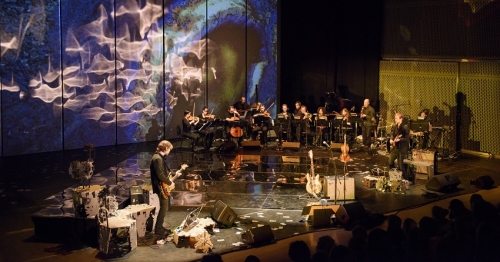 Artist Matthew Ritchie capped his 18-month residency at the ICA with The Long Count/The Long Game, a multimedia concert experience featuring Aaron and Bryce Dessner of The National, Kelly Deal of The Breeders, staged installations, and Tarot card readings, and a very memorable baseball bat.
Artist Matthew Ritchie capped his 18-month residency at the ICA with The Long Count/The Long Game, a multimedia concert experience featuring Aaron and Bryce Dessner of The National, Kelly Deal of The Breeders, staged installations, and Tarot card readings, and a very memorable baseball bat.
The legendary Mark Morris Dance Group returned to the ICA for the first time since 2007 to present an evening of dance elaborating on musical masterpieces.
 When the Stars Begin to Fall traveled from the Studio Museum in Harlem, placing works by self-taught, spiritually inspired, and incarcerated artists alongside projects by such prominent contemporary artists as Kara Walker, Kerry James Marshall, David Hammons, and Theaster Gates.
When the Stars Begin to Fall traveled from the Studio Museum in Harlem, placing works by self-taught, spiritually inspired, and incarcerated artists alongside projects by such prominent contemporary artists as Kara Walker, Kerry James Marshall, David Hammons, and Theaster Gates.

Armed with a vivid imagination and 400 Sharpies, artist Ethan Murrow created a massive seascape drawing inspired by the ICA’s own neighborhood on the museum’s sprawling Sandra and Gerald Fineberg Art Wall.

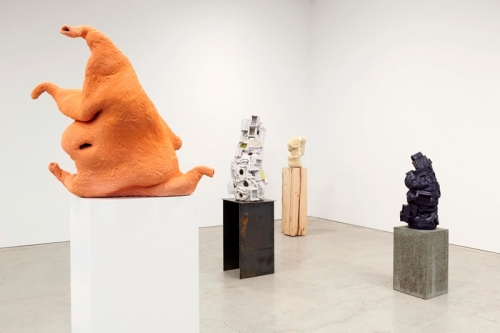 Arlene Shechet’s major survey filled the West Gallery with “some of the most imaginative sculpture of the past 20 years.” (New York Times)
Arlene Shechet’s major survey filled the West Gallery with “some of the most imaginative sculpture of the past 20 years.” (New York Times)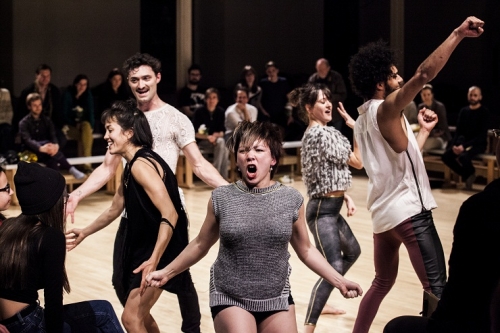 Faye Driscoll’s unforgettable performance Thank You For Coming: Attendance had audiences skipping, dancing, and happily donning ridiculous hats.
Faye Driscoll’s unforgettable performance Thank You For Coming: Attendance had audiences skipping, dancing, and happily donning ridiculous hats.
The Dubai-based collaborators combine artworks with everyday and offbeat objects in sincere and probing assemblages.
Ramin Haerizadeh, Rokni Haerizadeh, and Hesam Rahmanian draw from a wide range of material and cultural sources in their work, combining everyday and offbeat objects with their own artworks and those of other artists in sincere and probing assemblages. For The Birthday Party, their first major U.S. museum exhibition, the Dubai-based collaborators worked for the first time with a museum’s collection, choosing works by Louise Bourgeois, Jimmy De Sana, and Ree Morton to incorporate into their lively installation.
Some of the materials they transported from Dubai to pair with them are:
There’s something for everyone this vacation week at the ICA: three celebrated exhibitions, a bunch of fun, creative + FREE activities, wintry waterfront views, and many more reasons to spend the holidays with us!
Don’t miss one of the season’s most acclaimed exhibitions! Leap Before You Look: Black Mountain College 1933–1957 celebrates the memory and myth of a small liberal-arts school in North Carolina where the course of art history changed forever. Despite its brief existence, BMC became a seminal meeting place for many of the artists, musicians, poets, and thinkers who would become the principal practitioners in their fields of the postwar period.
Diane Simpson
See Diane Simpson’s “stunning work” in this “superb,” “riveting exhibition.” (Boston Globe)
Chicago-based artist Diane Simpson’s elegantly constructed sculptures evolve from a diverse range of materials, clothing, and architectural sources. While elements of her creations appear to effortlessly hang and fold, they are in fact the result of a rigorous approach to construction techniques, reveling in passages of pattern, joinery, and skewed angles that are by turns humorous and psychologically-charged. Diane Simpson is the artist’s first solo museum exhibition on the East Coast.
Ramin Haerizadeh, Rokni Haerizadeh, and Hesam Rahmanian: The Birthday Party
The artists “brought the spirit of their underground curation with them: challenge authority, work with friends, blur boundaries, and see what springs up.” (Boston Globe)
Watch Dubai-based artists Ramin Haerizadeh, Rokni Haerizadeh, and Hesam Rahmanian bring their collaborative artistic practice – and generous, inclusive aesthetic – to the ICA.The three Iranian artists—two brothers and their childhood friend—combine their individual work with that of other artists, in sculpture, painting, drawing, and video, to generate probing and beautiful environments.
The best adverts from across the pond are here! Celebrate commercial creativity with our holiday tradition, a screening of the British Arrows Awards. (We know you fancy it.)
Find the perfect present or accessory you never knew you desperately needed at the ICA store (recently named one of the best museum shops in the world!): we’re talking special products designed in collaboration with ICA exhibited artists, the best selection of art and photography books in New England, and home items intended to improve – and beautify! – your everyday living. Bring the delights of contemporary art home. PLUS all purchases support the exhibitions and programs of the ICA.